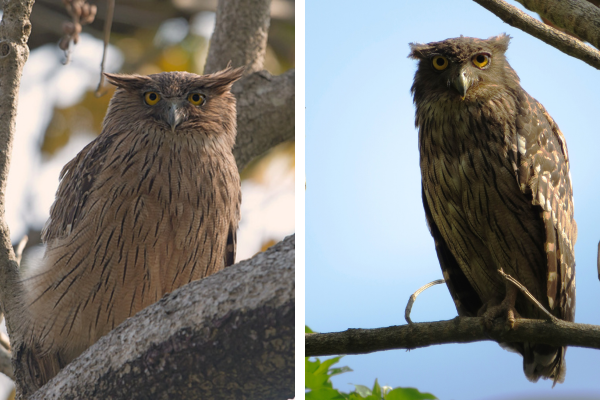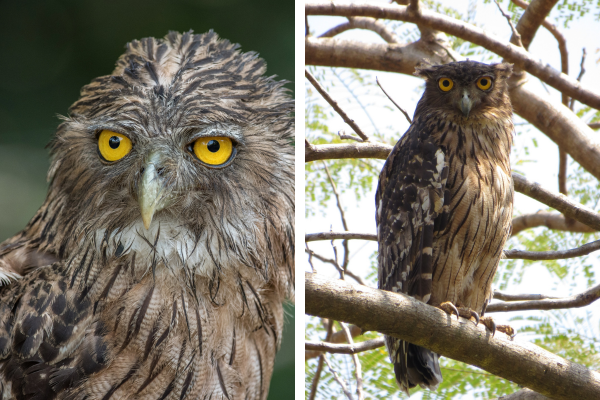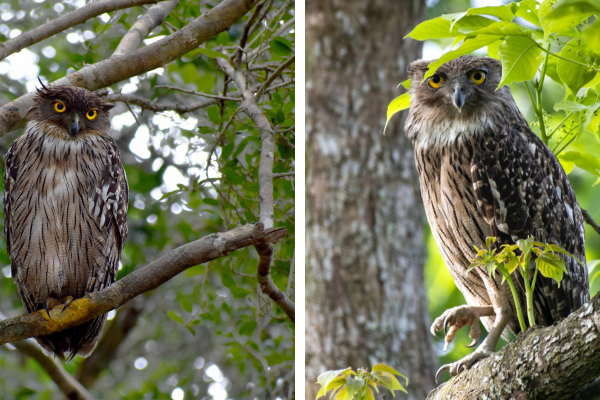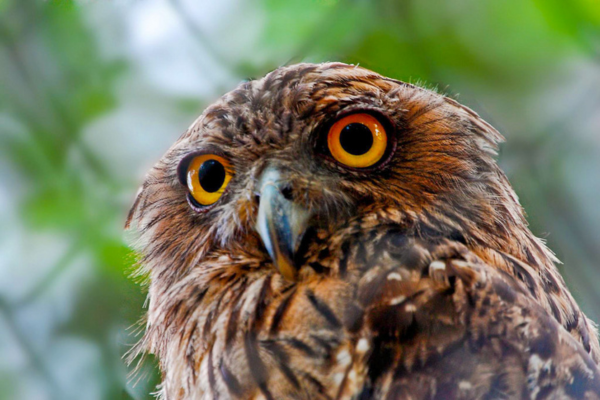The Brown Fish Owl (Ketupa zeylonensis) is a large, powerful owl found in South Asia and Southeast Asia, known for its distinctive look and expert fishing skills. It primarily feeds on fish but also hunts frogs, crabs, and small mammals. Preferring forests and wetlands near water, it is an adaptable bird that thrives in both natural and urban environments. While classified as “Least Concern” by the IUCN, its habitat is threatened by deforestation and human development, which could impact its population in the future.
Description:
• Appearance: The Brown Fish Owl has rufous-brown upperparts with dark brown or black streaks, and lighter, buffy to whitish underparts with dark brown streaks and finer barring. It has a white, puffed throat, golden-yellow eyes, and yellow, featherless feet. Females are slightly larger than males, and young owls are paler than adults.
• Size: The Owl measures 48-61 cm in length, having a wingspan of 125-140 cm. Its weight is 1.1-2.5 kg, but this varies based on subspecies.
• Adaptations for Fishing: The Brown Fish Owl has larger wings and long legs than other owls, along with rough-textured toes for catching fish. It also has impressive curved talons and a sharp keel underneath the middle claw to help it grip onto slippery fish.
Hunting Style: Contrary to other diurnal fish-eating birds such as the ospreys, the Brown Fish Owl does not plunge-dive into water. It rather wades through shallow water with its strong talons catching up the prey.
• Flight and Sound: This owl doesn’t have the soft feathers typical of other owls for silent flight. As a result, it has a noisy wing beat, sometimes described as producing a singing sound.
• Facial Features: The Brown Fish Owl has a bill positioned between its eyes, giving it a distinctive, somewhat “morose” look. Additionally, its facial disc is shallower than many other owls reflecting its reliance upon vision rather than sound for detection.
• Unique Characteristics: Unlike most owls, the Brown Fish Owl does not rely on sound for hunting. Its physical traits, such as its wing beat and bill placement, are adaptations for a fishing lifestyle in wetland and forested areas.
Habitat and Feeding Habits of the Brown Fish Owl:
• Geographic Range: The Brown Fish Owl is an all-year resident in tropical and subtropical regions of the Indian Subcontinent and Southeast Asia. Its range extends into the Levant and southern Asia Minor, though it’s rare or possibly extinct in some areas.
• Preferred Habitat: This owl species inhabits forests, woodlands, and littoral country with streams, lakes, and rice fields. It prefers habitats in the lowlands but is also found up to 1,500 meters (4,900 feet) in the foothills of the Himalayas.
• Adaptability: Brown Fish Owl is quite adaptable; most of its day is spent in shady trees such as groves of bamboos.
They can be seen near the water reservoir, canal, coastlines, and sometimes even villages on the periphery.
Western areas have more semi-arid conditions, where they can also breed in oasis of arid conditions.
• Water Dependence: While adaptable, the owl generally stays close to larger bodies of water, such as rivers and lakes, which provide ample food sources.

Population and Behaviour:
• Density: Brown Fish Owls are not typically found in high population densities due to their large predatory nature. However, in Sri Lanka, where human habitat changes have benefited the owl, they maintain a relatively high population.
• Human Interaction: The owl’s ability to adapt to human-altered environments, such as villages and plantations, has helped it thrive in some regions, though it always remains closely connected to water.
Diet and Feeding Behaviour:
Main Diet: As a fish-eating bird, the Brown Fish Owl primarily hunts species like carp, catfish, and mullet.
Hunting:
Hunts mainly at night. The sharp vision and excellent hearing make it locate prey during low-light hours of the day.
It swoops quietly and swiftly down on its prey using its robust talons to catch the prey, thus making it an effective predator in its aquatic habitat.
Varied Diet:
Being opportunistic also it preys on other aquatic animals such as crabs and frogs, and occasionally small mammals such as rats and mice.

Behavior and Ecology of the Brown Fish Owl
The Brown Fish Owl exhibits unique and fascinating behavior patterns that help it thrive in its aquatic environments.
• Vocalizations: The calls of the owl are different and consist of a low, humming “boom-uh-boom,” a “hup hup hu,” and a loud “huhuhuhuhuhuhu.” It releases a trisyllabic “tu-hoo-hoo” during the breeding season and is believed to be a territorial call. Its call is similar to the faraway sound of the Eurasian bittern.
• Activity and Hunting: Though primarily nocturnal, Brown Fish Owls have been observed to hunt in the daytime at times, particularly during overcast conditions. The owl hunts while sitting on a rock overhang or a hanging perch above the water, where it waits for prey.
At other times, it wades into shallow waters and catches its prey by flying just above the surface, with its long legs catching fish, frogs, and aquatic crustaceans such as crabs.
• Feeding Preferences:
It prefers places with abundant fish accessibility like ornamental ponds or commercial fisheries. Freshwater crabs comprise a huge amount of its diet in places such as the Melghat Tiger Reserve in India.
The Brown Fish Owl rarely scavenge carrion and rarely feeds on land-based animals except when there is a lack of food supply—something very unusual for owls.
• Competition and Interactions: The Brown Fish Owl shares its habitat with other large predators like Pallas’s Fish Eagle and the Dusky Eagle Owl. While these species may compete for similar food sources, the Brown Fish Owl is more terrestrial and consumes a greater variety of invertebrates, whereas the eagle focuses primarily on fish and water birds. The owl is adaptable and can scavenge when needed, a rare behavior among its kind.
• Prehistoric Behavior : The Brown Fish Owl is sometimes correlated with the prehistoric Bubo insularis, which exhibited foot anatomy akin to that of an eagle owl. This hints that the owlet may earlier have preyed on terrestrial species, such as the now-extinct Sardinian pika, due to climate change and habitat destruction.
IUCN Status of the Brown Fish Owl: A Species of Least Concern
The Brown Fish Owl mainly inhabits forested environments, wetland areas, and regions adjacent to water bodies including rivers, lakes, and streams. It adapts very well to these lifestyles, which contain an abundance of food resources: fish, frogs, and other crustaceans. This capability of the owl to live either in rural areas or in an urban habitat along a waterway has allowed the species to thrive in stable ranges.
Although the Brown Fish Owl is classified as “Least Concern” on the IUCN Red List, it still faces threats from habitat loss. Deforestation and urban expansion continue to encroach on the habitat of the owl, which might affect its food supply. As such, though the species is not currently threatened, these changes in the environment may lead to population declines in the future if habitat loss continues. Therefore, protecting the owl’s wetlands and forest habitats is essential for ensuring its long-term survival.


